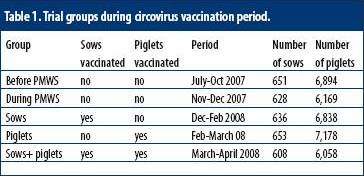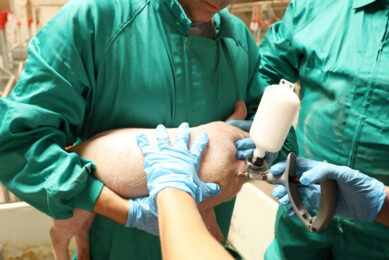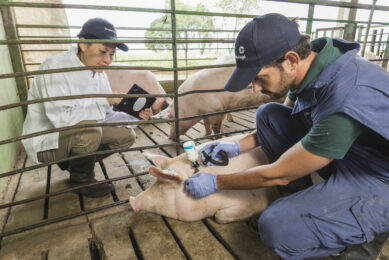PCV2 symposium explores vaccination strategies

Last March, around 400 delegates went to Athens in Greece to ‘gain some wisdom’ about Porcine Circovirus Disease (PCVD) at a forum organised by French animal health company Merial. Topics covered included both scientific and practical angles.
By Dick Ziggers
Athens, Greece was the location to discuss the ins and outs of the number one troublemaker in the pig industry – Porcine Circovirus 2 (PCV2). Around 400 veterinarians working in the pig industry listened to scientific and practical presentations and discussed their experiences afterwards in this historical setting.
Very aptly, Kenneth McCullough described PCVD as ‘when immunology goes wrong,’ – he had already done that at the American Association of Swine Veterinarians’ conference in 2007 and returned to Athens to explore more.
McCullough is head of research at the Immunology department at the Swiss Institute of Virology in Mittelhäusern.
The disease has thoroughly been studied by scientists but still a lot remains unclear. One of the critical points in understanding the pathogenesis of PCV2 infection is the balance between the host immune defences responding to the presence of the virus, and the capacity of the virus to interfere with immune defence development. During his presentation McCullough elaborated on the interactions of PCV2 with immunity and was assisted by Finnish Tuija Kekarainen, who works at the Centre de Recerca en Sanitat Animal (CReSA) in Spain.
Maternal immunity
When PCV2 infects piglets still protected by maternal immunity, either the virus infection is prevented by maternal immunity, or the residual immunity can enhance the ability of the piglet to resist infection and develop its own immune response. In the latter case a ‘normal’ activation of the immune system occurs: the innate defences remain intact, dendritic cells1 function and mature normally, and the animal will mount an effective immune response against PCV2 and other pathogens.
This contrasts with PCV2 infection in an unprotected piglet. In these cases the infection of dendritic cells will reduce their ability to recognise danger, resulting in reduced innate defence competence. The immune system as a whole is no longer capable of responding efficiently to pathogen attack, setting the scene for the development of diseases such as PMWS and other PCVD. Merial’s vaccine against PCV2 (Circovac®) is an inactivated vaccine targeted at sows in order to protect their offspring by a high quality passive immunity.
Managing PCVD in fattening units
The result of using such a vaccine is of most interest to the pig farmer. To illustrate its functionality on farms a few veterinarians were asked to present their results from practice. UK pig practitioner Jake Waddilove discussed the management of PCVD in fattening units.
“Late stage – or endemic – PCVD as we call it, occurs in 60-80 kg pigs. We see typical wasters, and also many pneumonias.” Waddilove presented four case studies where PCVD was acutely present in fattening, with
different clinical expressions, including granulomatous enteritis. On a 200-sow farrow-to-finish operation, PCVD was present for seven years, and ileitis had been diagnosed, but remained out of control even after Lawsonia vaccination.
The implementation of sow vaccination was followed by a ‘dramatic reduction’ in the incidence of scours. Tylosin medication was withdrawn without adverse effects. As on three other farms, a comparable reduction in antibiotic use was obtained. In a 4,000-place finisher herd where severe respiratory outbreaks were the rule, when vaccinated progeny came through, the average mortality fell from over 2% to below 1% and total medication costs dropped more than ten-fold (from £0.36 to £0.03 per pig).
“We are starting to get a hold on PCVD in finishers,” said Waddilove. “It appears that sow vaccination can have real impact on the levels of PCVD in finishing herds, while allowing reduced antibiotic use.”
The effects are not only a result of vaccination, according to Waddilove. “Of course we took some management measures, such as improving pig flow on the farms, all in – all out, multiple site management, etc. One good thing about PCVD is that we manage our farms better. And vaccination makes our life a lot easier.”
Subclinical forms of PCVD
“In the region where I work, the performances of fattening units had not improved over the last five years, with an average mortality over 2.5%,” said Cees Veldman, pig practitioner in the Netherlands. Implementation of the vaccine restored some satisfaction in farmers, as Veldman demonstrated through four case studies. For example, in a 740-sow, 7,500-fattener operation, mortality was above 3.5% during the second half of the fattening period, and average daily gain at 770 g/day. There was no mixing of piglets for the first three days of their life.
Vaccination of pigs against pleuropneumonia resulted in an improved situation for three months. Piglets were vaccinated against PCV2 at eight weeks of age, which lead to a sharp decline in mortality (>50%), and a spectacular decrease in the use of antibiotics (-35%).
“This particularly meets the very strong demand of Dutch consumers,” Veldman added.
In a multiplier 1,400-sow farm, which sells piglets to off-site fattening units, respiratory disease and meningitis caused 4% to 10% mortality among weaners. In October 2008, sows and piglets (at six weeks) were vaccinated, which produced a rapid improvement in fattening results.
“Also mortality dropped by 4% in maternity and by 1% post-weaning. Our target is to switch to sow vaccination alone within four to five months,” Veldman said.
Vaccination strategies
Prof Dr Zygmunt Pejsak (National Veterinary Research Institute, Pulawy, Poland) described a trial that had been carried out at a large farrow-to-finish facility in Poland, housing 2,550 sows, to compare the efficacy of three different vaccination strategies. The farm was affected with an acute form of PCVD. General details of the farm included a weekly insemination of 110 sows, piglet weaning at 28 days and transfer to the fattening units at 90 days. On average at this farm sows produced 19.8 pigs per year and annually 50,000 fatteners are sold.
In previous years, the farm used to be collectively managed. Before the trials, it had a high infection pressure: PCV2, Mycoplasma hyopneumoniae, Bordetella bronchiseptica, Pasteurella multocida – DNT, Actinobacillus pleuropneumoniaea, Haemophilus parasuis type 2, Streptococcus suis have been diagnosed. The farm was free of PRRS and Aujeszky’s Disease. A PMWS outbreak was diagnosed in November 2007, through clinical signs (wasting, anaemia, respiratory disorders), and increased mortality during nursery and growing phases (from 17 to 29%). Diagnosis was confirmed in the laboratory.
To obtain relevant information about the vaccination strategy, several trials were carried out in different periods with different groups of pigs as shown in Table 1. Different periods could be observed, before and during PMWS and during vaccinations. Sows were vaccinated six and two weeks before farrowing, through injections of 2 ml. Piglets were vaccinated at weaning through injections of 0.5 ml. When sows and piglets were vaccinated, the moments of vaccination for sows remained the same, but piglets born from vaccinated sows were vaccinated at seven weeks of age.
The producer, a former researcher, was keeping records and documented mortality rate, carcass weight, average daily gain and feed conversion ratios of the treated animals. The average results are shown in Table 2.
One of the conclusions drawn was that there was a significant decrease in mortality rate after vaccination. Pejsak attributed this decrease to the success of all vaccination protocols. The decrease could be observed up until the end of the fattening period. Due to the vaccinations the health status of the farm returned to the situation as it was before the PCVD outbreak. In addition, a significant improvement in growth could be observed. Average daily growth rate was even better after vaccination than before the PCVD outbreak. “There is difference between the vaccination programmes,” said Pejsak, “but it cannot be distinguished whether this is due to the protocol or as a ‘time effect’ on the viral pressure in the stables.”
Remaining questions are related to parameters that seem to differ before and after the PMWS situation. Could there already have been a subclinical form of the disease present? Also there was improvement with repeated vaccination, which might be an effect of vaccination on viral pressure.
Pejsak concluded that there was an overall significant improvement of all parameters after vaccination against PCV2. Health status production parameters improved after vaccination similar or even better to the situation before PMWS. “All vaccination protocols were a success. The efficacy of sow vaccination was found on all parameters and lasted until the end of the fattening period.”
Return on investment
Questions on the economical effects of vaccination programmes were also addressed. Using the Merial vaccine, Pejsak came to the conclusion that, when only sows are vaccinated ROI is 1:9, vaccinating piglets only brings a ROI of 1:4 and vaccinating sows and piglets decreases ROI to 1:3. On the other hand, in the last situation health status of the farm is improved the most and management and animal quality are at its best.
Source: Pig Progress Volume 25 nr 3











